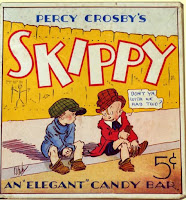Skippy started in Life magazine as a an American comic strip drawn by Percy Crosby from 1920 to 1945 and later went on to be featured in radio and the movies, etc.
It was kind of a forerunner of the kind of strip drawn by Charles Schulz or Hank Ketcham about the mischief and adventures young boys get into.
The hydrogenated peanut butter bearing the name "Skippy" was first marketed by Joseph Rosefield in California in 1932 or 1933 (depending on which Wikipedia page you consult), without obtaining permission from Crosby, with litigation continuing even up to the present day. Crosby had their trade mark invalidated shortly after it was used, but Rosefield paid no mind to Crosby and got the trademark finally in 1945. Meanwhile Crosby dissolved into alcoholism, right wing politics, and was institutionalized in 1948. The strip died from excessive querulousness and money disputes in 1945.
Joseph Rosefield, of Alameda, California in fact "invented" non-separating peanut butter through the hydrogenation process ten years earlier and licensed his process to a competing brand "Peter Pan." Before that peanut butter typically would always have to be re-mixed periodically to prevent the separation of peanut oil on the surface. It would also tend to spoil. This gave the peanut butter a creamy consistency and a guaranteed shelf life of one year. His company and its product became a huge success in the 1940s and 1950s and was sold to Best Foods in 1955.
Best Foods at the time was the manufacturer of Hellman's Mayonnaise for mostly East Coast markets and its own brand of Mayonnaise on the West Coast. Richard Hellman was an immigrant from Germany who opened a deli on Columbus Avenue in New York in 1905. His wife's recipe for mayonnaise became so popular that he went into manufacturing the product. In 1932 Best foods bought Hellman's mayonnaise business. After Best Foods acquired Skippy and Rosefield packing company in 1955 it was itself bought out by the Corn Products Refining Company in 1958 to become Corn Products Company and in 1969 CPC International. In 1997 CPC International spun off Bestfoods and became Corn Products International and in 2012 was renamed Ingredion. Bestfoods was bought by Unilever three years later.
Unilever is an enormous Anglo-Dutch consumer products company, one of the largest on the planet after Proctor and Gamble, and Nestle. It manufactures Skippy today. Getting back to peanut butter, Skippy is currently manufactured in two places: Little Rock, Arkansas in the US and Shandong Province in China.
--------------------------------------------------------------------------------------------------------------
Jif originated in 1958 as a product of Proctor and Gamble of Cincinnati, Ohio. It had a mascot, the Jifaroo, a blue Kangaroo.
By 1981 it was the leading peanut butter sold worldwide. It is manufactured in Lexington, Kentucky in the largest peanut butter factory in the world. It was sold to JM Smucker Company of Orrville, Ohio, in 2001.
-----------------------------------------------------------------------------------
Peter Pan Peanut Butter was originally a product of Swift and Company's Derby Foods division, and introduced in 1920 originally as "E.K. Pond's Peanut Butter". In 1928 it was renamed as Peter Pan after the JM Barrie character.
J.M. Barrie was a British playwright and writer (1860-1937) who created Peter Pan in 1902 and wrote his most well known play featuring the character around that time. In 1953 Walt Disney produced their animated film "Peter Pan" after licensing their rights to the name from Great Ormond Street Hospital for Children located in the Bloomsbury section of London,
which received the copyright from J.M. Barrie in 1929. Disney in turn has licensed characters from the film to the makers of Peter Pan peanut butter.
Con Agra foods of Omaha, Nebraska is currently owner of Peter Pan. It is another food conglomerate. Their manufacturing plant is in Sylvester, Georgia.
----------------------------------------------------------------------------------
Beech-Nut Peanut Butter was the leading brand in 1921. It originated as Imperial Packing Company in 1891 and changed its name to Beech-Nut in 1898. By the time I had heard of Beech-Nut their main product was Chewing gum and was acquired by Milnot Holding Company. Milnot later was acquired by J.M. Smucker company, which currently also owns the Jif brand of peanut butter.
Beech nut, started by a group of brothers in Canajoharie New York, started out making hams, butter, and many common household food products, narrowed its focus to candy, chewing gum, and baby food later on. At some time early on, it got out of the peanut butter business.
--------------------------------------------------------------------------------
Laura Scudders claim to fame was the wax paper bag for holding potato chips, around which she founded her food company in 1926. She was trained as a lawyer and was from Monterey Park, California. Somewhere along the line she also made peanut butter which is still made.
In 1987 Laura Scudders Foods was sold to Borden, a dairy products giant. A year later Borden closed most of the California plants of Laura Scudders because of labor problems. It was bought by the Granny Goose subsidiary, but a year later Granny Goose was were put up for sale and the potato chip portion of the business was sold to Snack Alliance Inc. which was later acquired by Shearer's Foods. By 1994 BAMA foods owned Laura Scudder's Peanut butter business, which was acquired by current owner JM Smucker & Company, owner of what is left of Beech-Nut and the leading brand today, Jif. Laura Scudders Peanut butter is now carving out a niche in specialty peanut butter, trading on the "old fashioned" and "all natural" tags, and reverting back to a time when Rosefield's partially hydrogenated products were not used.
The irony of all this is that in the 1920s, Skippy was supposedly better because it was "partially hydrogenated" and lacked the stickiness and annoying qualities of peanut butter that separated. Now the same qualities that your great grandmother turned against are now a plus. Oh well. Whatever sells peanut butter.












No comments:
Post a Comment